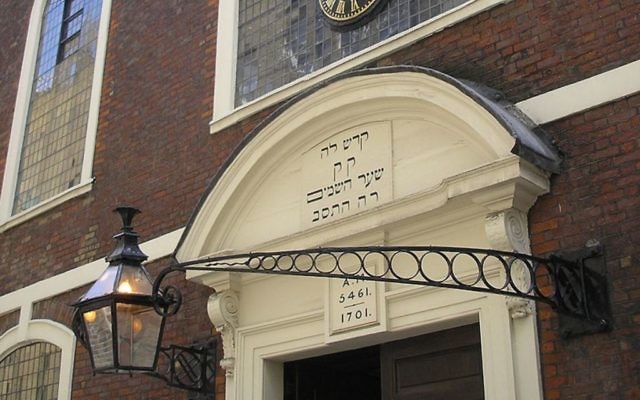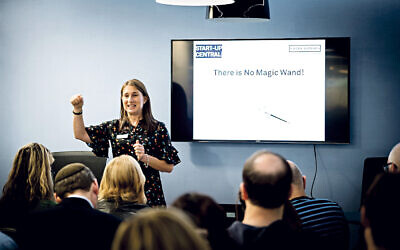OPINION: Can we please have our eruv back?
Jewish News' historian Derek Taylor examines the precedent for an eruv in the City of London.
History demonstrates the existence of an eruv in the 18th century. So why does Bevis Marks need to ask three local authorities for permission to establish one in the centre of London today?
Now, it took years to get agreement to create an eruv in north London because local authorities are often cautious about innovations. Look at the disgraceful decision of Barnet Council recently not to allow the Muslim community to create a cultural centre in the old Hippodrome in Golders Green.
Fortunately, Bevis Marks don’t have to ask for an innovation. When we first came over from Holland in the 17th century, in Stuart times, the community found the basis for an eruv already in existence.
How do we know? Because of a sermon given by Chief Rabbi Hart Lyon who served the community from 1756-1763.

Surprise, surprise: Hart Lyon was not impressed by the standard of observance of the members of the Great Synagogue in the City and one Rosh Hashanah he laid into them from the pulpit.
The members were shaving their beards, the young people were being immoral, the Sabbath was being desecrated, non-Jewish servants were being used to light fires on Shabbat and to make tea and coffee on the sabbath. Worst of all, “people carry things on the day of rest even outside the city boundaries.”
“Even outside the city boundaries”. So, presumably it was alright to carry things inside the city boundaries. The city boundaries were, of course, the city walls. That made inside the city walls an eruv.
Hart Lyon never did get the community to live up to his standards. He accepted a post on the continent which paid him less money but promised to get him a dozen students.
The Stuart eruv wasn’t even the only one. There was a cholera epidemic which killed 32,000 people in London in 1831 and 1832. When it finally came to an end, a philanthropic Jew built an estate of houses in the East End to improve the accommodation of poor people. When it was completed he asked Chief Rabbi Solomon Herschell for permission to have the estate designated an eruv which Herschell approved as the head of his Beth Din.

Of course, an eruv has to be clearly marked out and much of the city walls have now been destroyed. It seems highly unlikely that the Stuart city fathers knew that the Jews were using the city walls for an eruv, but at least we now have Bevis Marks, the distinguished 1700 ancient monument, and it is to be hoped that the construction of some poles, amid so many others, will not worry the local authorities too much. They agreed not to allow an enormous skyscraper to take the ancient lights of Bevis Marks, and the synagogue will still be used for the most important Jewish services.
There is one other error which hasn’t been corrected. We celebrate our return to Britain in Cromwell’s time as the beneficent decision of the Protector. Cromwell didn’t allow us back. He said if we came back, we were not to be harassed. There was no law passed in his time to rescind the 1290 expulsion order.
First of all, we were expelled by Edward I and as Edward II didn’t sign another expulsion order, we could have come back when he was on the throne. Nobody bothered to establish this. Second, there wasn’t sufficient support for Cromwell to pass a law letting us back. Which was lucky, because Charles II abrogated almost all of Cromwell’s laws to prove he was back on the throne.
There is a letter in the Scottish records office from Charles’s aide de camp, during his exile, promising to let us back if we supported him financially in Holland. Which we did. When a delegation of City of London merchants asked him to throw us out again, he turned them down.
It was Charles who let us come back. Can we have our eruv back please?

Thank you for helping to make Jewish News the leading source of news and opinion for the UK Jewish community. Today we're asking for your invaluable help to continue putting our community first in everything we do.
For as little as £5 a month you can help sustain the vital work we do in celebrating and standing up for Jewish life in Britain.
Jewish News holds our community together and keeps us connected. Like a synagogue, it’s where people turn to feel part of something bigger. It also proudly shows the rest of Britain the vibrancy and rich culture of modern Jewish life.
You can make a quick and easy one-off or monthly contribution of £5, £10, £20 or any other sum you’re comfortable with.
100% of your donation will help us continue celebrating our community, in all its dynamic diversity...
Engaging
Being a community platform means so much more than producing a newspaper and website. One of our proudest roles is media partnering with our invaluable charities to amplify the outstanding work they do to help us all.
Celebrating
There’s no shortage of oys in the world but Jewish News takes every opportunity to celebrate the joys too, through projects like Night of Heroes, 40 Under 40 and other compelling countdowns that make the community kvell with pride.
Pioneering
In the first collaboration between media outlets from different faiths, Jewish News worked with British Muslim TV and Church Times to produce a list of young activists leading the way on interfaith understanding.
Campaigning
Royal Mail issued a stamp honouring Holocaust hero Sir Nicholas Winton after a Jewish News campaign attracted more than 100,000 backers. Jewish Newsalso produces special editions of the paper highlighting pressing issues including mental health and Holocaust remembrance.
Easy access
In an age when news is readily accessible, Jewish News provides high-quality content free online and offline, removing any financial barriers to connecting people.
Voice of our community to wider society
The Jewish News team regularly appears on TV, radio and on the pages of the national press to comment on stories about the Jewish community. Easy access to the paper on the streets of London also means Jewish News provides an invaluable window into the community for the country at large.
We hope you agree all this is worth preserving.






















